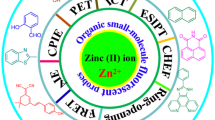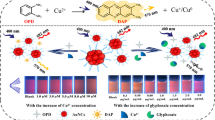Abstract
Copper nanoclusters (CuNCs) were synthesized starting from glutathione and copper(II) nitrate. They show blue fluorescence peaking at 432 nm when excited at 334 nm. In the presence of o-phenylenediamine (OPD), the blue fluorescence is decreased, but a yellow fluorescence appears with a peak at 557 nm. UV-visible absorptiometry, fluorometry and fluorescence lifetime measurements were used to show that OPD is oxidized by the small fraction of copper(II) ions present in the CuNCs to form the oxidized form of o-phenylenediamine (oxOPD) which displays weak yellow fluorescence, while the blue fluorescence decreases. The ratio of fluorescences at 557 and 432 nm increases linearly in the 0.15 to 110 μg·L−1 OPD concentration range, and the detection limit is 93 ng·L−1. Compared to the method based on the use of dissolved Cu(II), the employment of CuNCs reduces the detection limit by a factor of 40. The method was applied to the determination of OPD in spiked environmental water and industrial wastewater samples. Recoveries ranged from 96.8 to 100.3%.

Schematic presentation of a ratiometric fluorometric method for detection of o-phenylenediamine (OPD) based on copper nanoclusters (CuNCs). OPD is oxidized by Cu2+ present in CuNCs to form the oxidized form of o-phenylenediamine (oxOPD). FRET occurred between oxOPD and CuNCs, and the F557/F432 value is amplified.






Similar content being viewed by others
References
Qi H, Yue S, Bi S, Ding C, Song W (2018) Isothermal exponential amplification techniques: from basic principles to applications in electrochemical biosensors. Biosens Bioelectron 110:207–217. https://doi.org/10.1016/j.bios.2018.03.065
Ding C, Zhang W, Wang W, Chen Y, Li X (2015) Amplification strategies using electrochemiluminescence biosensors for the detection of DNA, bioactive molecules and cancer biomarkers. Trends Anal Chem 65:137–150. https://doi.org/10.1016/j.trac.2014.10.015
Li J, Fu W, Bao J, Wang Z, Dai Z (2018) Fluorescence regulation of copper nanoclusters via DNA template manipulation toward design of a high signal-to-noise ratio biosensor. ACS Appl Mater Interfaces 10:6965–6971. https://doi.org/10.1021/acsami.7b19055
Gao X, Wang X, Li Y, He J, Yu HZ (2018) Exonuclease I-hydrolysis assisted electrochemical quantitation of surface-immobilized DNA hairpins and improved HIV-1 gene detection. Anal Chem 90:8147–8153. https://doi.org/10.1021/acs.analchem.8b01445
Li B, Xu L, Chen Y, Zhu W, Shen X, Zhu C, Luo J, Li X, Hong J, Zhou X (2017) Sensitive and label-free fluorescent detection of transcription factors based on DNA-ag nanoclusters molecular beacons and exonuclease III-assisted signal amplification. Anal Chem 89:7316–7323. https://doi.org/10.1021/acs.analchem.7b00055
Liu S, Wang Y, Zhang S, Wang L (2017) Exonuclease-catalyzed methylene blue releasing and enriching onto a dodecanethiol monolayer for an immobilization-free and highly sensitive electrochemical nucleic acid biosensor. Langmuir 33:5099–5107. https://doi.org/10.1021/acs.langmuir.6b04671
Du YC, Cui YX, Li XY, Sun GY, Zhang YP, Tang AN, Kim K, Kong DM (2018) Terminal deoxynucleotidyl transferase and T7 exonuclease-aided amplification strategy for ultrasensitive detection of uracil-DNA glycosylase. Anal Chem 90:8629–8634. https://doi.org/10.1021/acs.analchem.8b01928
Wang Y, Bai J, Huo B, Yuan S, Zhang M, Sun X, Peng Y, Li S, Wang J, Ning B, Gao Z (2018) Upconversion fluorescent aptasensor for polychlorinated biphenyls detection based on nicking endonuclease and hybridization chain reaction dual-amplification strategy. Anal Chem 90:9936–9942. https://doi.org/10.1021/acs.analchem.8b02159
Miao X, Cheng Z, Ma H, Li Z, Xue N, Wang P (2018) Label-free platform for microRNA detection based on the fluorescence quenching of positively charged gold nanoparticles to silver nanoclusters. Anal Chem 90:1098–1103. https://doi.org/10.1021/acs.analchem.7b01991
Peng W, Zhao Q, Piao J, Zhao M, Huang Y, Zhang B, Gao W, Zhou D, Shu G, Gong X, Chang J (2018) Ultra-sensitive detection of microRNA-21 based on duplex-specific nuclease-assisted target recycling and horseradish peroxidase cascading signal amplification. Sensors Actuators B Chem 263:289–297. https://doi.org/10.1016/j.snb.2018.02.143
Zhou F, Li B (2015) Exonuclease III-assisted target recycling amplification coupled with liposome-assisted amplification: one-step and dual-amplification strategy for highly sensitive fluorescence detection of DNA. Anal Chem 87:7156–7162. https://doi.org/10.1021/acs.analchem.5b00993
**ao M, Man T, Zhu C, Pei H, Shi J, Li L, Qu X, Shen X, Li J (2018) MoS2 nanoprobe for microRNA quantification based on duplex-specific nuclease signal amplification. ACS Appl Mater Interfaces 10:7852–7858. https://doi.org/10.1021/acsami.7b18984
Liu Y, Zhu D, Cao Y, Ma W, Yu Y, Guo M, **ng X (2018) A novel universal signal amplification probe-based electrochemiluminescence assay for sensitive detection of pathogenic bacteria. Electrochem Commun 85:11–14. https://doi.org/10.1016/j.elecom.2017.10.012
Lu Q, Chen X, Liu D, Wu C, Liu M, Li H, Zhang Y, Yao S (2018) Synergistic electron transfer effect-based signal amplification strategy for the ultrasensitive detection of dopamine. Talanta 182:428–432. https://doi.org/10.1016/j.talanta.2018.01.068
Song D, Yang R, Fang SY, Liu YP, Long F (2018) A FRET-based dual-color evanescent wave optical fiber aptasensor for simultaneous fluorometric determination of aflatoxin M1 and ochratoxin A. Microchim Acta 185:508. https://doi.org/10.1007/s00604-018-3046-5
Saberi Z, Rezaei B, Faroukhpour H, Ensafi AA (2018) A fluorometric aptasensor for methamphetamine based on fluorescence resonance energy transfer using cobalt oxyhydroxide nanosheets and carbon dots. Microchim Acta 185:303. https://doi.org/10.1007/s00604-018-2842-2
Li N, Liu SG, Fan YZ, Ju YJ, ** on emission to highly sensitive picric acid sensing. Anal Chim Acta 1013:63–70. https://doi.org/10.1016/j.aca.2018.01.049
Chen S, Yu YL, Wang JH (2018) Inner filter effect-based fluorescent sensing systems: a review. Anal Chim Acta 999:13–26. https://doi.org/10.1016/j.aca.2017.10.026
Fang H, **e N, Ou M, Huang J, Li W, Wang Q, Liu J, Yang X, Wang K (2018) Detection of nucleic acids in complex samples via magnetic microbead-assisted catalyzed hairpin assembly and “DD–A” FRET. Anal Chem 90:7164–7170. https://doi.org/10.1021/acs.analchem.8b01330
Yan X, Li H, Han X, Su X (2015) A ratiometric fluorescent quantum dots based biosensor for organophosphorus pesticides detection by inner-filter effect. Biosens Bioelectron 74:277–283. https://doi.org/10.1016/j.bios.2015.06.020
Xu S, Nie Y, Jiang L, Wang J, Xu G, Wang W, Luo X (2018) Polydopamine nanosphere/gold nanocluster (AuNC)-based nanoplatform for dual color simultaneous detection of multiple tumor-related microRNAs with DNase-I-assisted target recycling amplification. Anal Chem 90:4039–4045. https://doi.org/10.1021/acs.analchem.7b05253
Wang Y, Yao G, Zhu P, Hu X (2011) Indirect biamperometric determination of o-phenylenediamine in lab-on-valve format using reversible indicating redox system. Analyst 136:829–834. https://doi.org/10.1039/c0an00713g
Das NK, Ghosh S, Priya A, Datta S, Mukherjee S (2015) Luminescent copper nanoclusters as a specific cell-imaging probe and a selective metal ion sensor. J Phys Chem C 119:24657–24664. https://doi.org/10.1021/acs.jpcc.5b08123
Yu RJ, Sun JJ, Song H, Tian JZ, Li DW, Long YT (2017) Real-time sensing of o-phenylenediamine oxidation on gold nanoparticles. Sensors 17:530–536. https://doi.org/10.3390/s17030530
Liu S, Qin XY, Tian JQ, Wang L, Sun XP (2012) Photochemical preparation of fluorescent 2,3-diaminophenazine nanoparticles for sensitive and selective detection of hg (II) ions. Sensors Actuators B Chem 171-172:886–890. https://doi.org/10.1016/j.snb.2012.05.089
Li R, Lei C, Zhao XE, Gao Y, Gao H, Zhu S, Wang H (2018) A label-free fluorimetric detection of biothiols based on the oxidase-like activity of ag+ ions. Spectrochim Acta A 188:20–25. https://doi.org/10.1016/j.saa.2017.06.056
Zhao XE, Lei C, Gao Y, Gao H, Zhu S, Yang X, You J, Wang H (2017) A ratiometric fluorescent nanosensor for the detection of silver ions using graphene quantum dots. Sensors Actuators B Chem 253:239–246. https://doi.org/10.1016/j.snb.2017.06.086
Zu F, Yan F, Bai Z, Xu J, Wang Y, Huang Y, Zhou X (2017) The quenching of the fluorescence of carbon dots: a review on mechanisms and applications. Microchim Acta 184:1899–1914. https://doi.org/10.1007/s00604-017-2318-9
Li N, Gu Y, Gao M, Wang Z, **ao D, Li Y, Lin R, He H (2015) Colorimetric determination of o-phenylenediamine in water samples based on the formation of silver nanoparticles as a colorimetric probe. Spectrochim Acta A 140:328–333. https://doi.org/10.1016/j.saa.2014.12.053
Ma P, Liang F, Wang D, Yang Q, Cao B, Song D, Gao D, Wang X (2015) Selective determination of o-phenylenediamine by surface-enhanced raman spectroscopy using silver nanoparticles decorated with α-cyclodextrin. Microchim Acta 182:167–174. https://doi.org/10.1007/s00604-014-1314-6
Wang SP, Huang TH (2005) Separation and determination of aminophenols and phenylenediamines by liquid chromatography and micellar electrokinetic capillary chromatography. Anal Chim Acta 534:207–214. https://doi.org/10.1016/j.aca.2004.11.038
Dong S, Chi L, Zhang S, He P, Wang Q, Fang Y (2008) Simultaneous determination of phenylenediamine isomers and dihydroxybenzene isomers in hair dyes by capillary zone electrophoresis coupled with amperometric detection. Anal Bioanal Chem 391:653–659. https://doi.org/10.1007/s00216-008-2053-5
Acknowledgments
This work was supported by the National Natural Science Foundation of China (Nos. 21575043, 21275056, 21605052, 51478196); and the Platform Construction Project of Guangzhou Science Technology and Innovation Commission (No. 15180001).
Author information
Authors and Affiliations
Corresponding authors
Ethics declarations
The author(s) declare that they have no competing interests.
Additional information
Publisher’s note
Springer Nature remains neutral with regard to jurisdictional claims in published maps and institutional affiliations.
Electronic supplementary material
ESM 1
(DOC 2.99 mb)
Rights and permissions
About this article
Cite this article
Ma, Y., Yu, Y., Lin, B. et al. A novel signal amplification strategy based on the use of copper nanoclusters for ratiometric fluorimetric determination of o-phenylenediamine. Microchim Acta 186, 206 (2019). https://doi.org/10.1007/s00604-019-3327-7
Received:
Accepted:
Published:
DOI: https://doi.org/10.1007/s00604-019-3327-7




